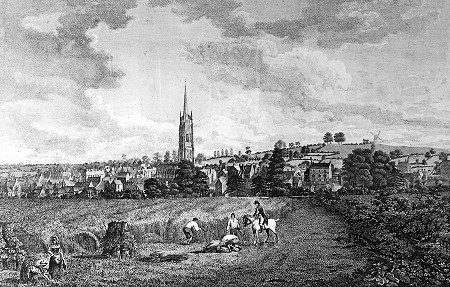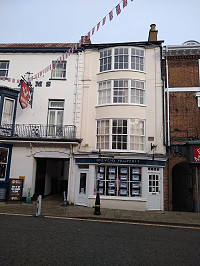Bartholomew Howlett

Northwest View of the Town of Louth

Howlett house
As we accumulate more material in the museum archives, we get breakthrough moments when information from diverse sources comes together. One such moment was when Richard Gurnham identified the house of the Howlett family in Louth in the late 18th century.
Bartholomew Howlett was a Louth-born artist who became well known nationally for his drawings and engravings, particularly his book, ‘A Selection of Views in the County of Lincoln’, published in 1801. Howlett was a contemporary of Louth schoolmaster Thomas Espin, although they cannot have spent long periods together in Louth as it was only in 1790 that Espin moved to Louth, and by then Howlett was based in London. Espin and Howlett collaborated to produce several outstanding works such as ‘Northwest View of the Town of Louth’, 1793 and ‘Louth Steeple from the Hermitage’, 1807.
When Howlett died at Newington in Greater London in 1827, aged 60, his obituary in The Gentleman’s Magazine referred to him as ‘a pleasing artist’ but concluded by saying ‘Sorry are we to add that the latter days of this worthy and industrious man were embittered by pecuniary distress. He has left a widow in a very destitute state.’
Bartholomew Howlett was born in Louth in 1767, and he became apprenticed to James Heath, an engraver in London. National records show that in 1803, when he was living in Lambeth, Howlett married Johanna Curling, and the same year he took on an apprentice Joseph Henry Elliot.
Surprisingly little has been generally known about Howlett’s early life. The 1792 directory lists Bartholomew Howlett as a whitesmith in Louth – he was the father of artist Bartholomew Howlett. It is from General J H Loft’s 1840 listing of graves in St Mary’s Cemetery, that we find information about the Howlett family. General Loft not only recorded the information inscribed on the gravestones, but he also added notes about the deceased. Loft’s notes tell us that “Bartholomew Howlett was a whitesmith in the Butcher Market, his house and premises adjoined the Masons Arms Inn. He and his wife Judith were the parents of Batholomew Howlett a respectable engraver in London.”
The building to the west of the Masons Arms had never been a house (now The Halifax; formerly it was the Corn Exchange, and before that, the Theatre), but immediately east of the Masons Arms is a narrow four-storey house with bow windows. This must have been the premises of the Howlett family.